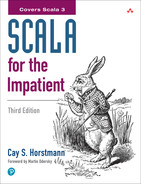Foreword to the First Edition
When I met Cay Horstmann some years ago he told me that Scala needed a better introductory book. My own book had come out a little bit earlier, so of course I had to ask him what he thought was wrong with it. He responded that it was great but too long; his students would not have the patience to read through the eight hundred pages of Programming in Scala. I conceded that he had a point. And he set out to correct the situation by writing Scala for the Impatient.
I am very happy that his book has finally arrived because it really delivers on what the title says. It gives an eminently practical introduction to Scala, explains what’s particular about it, how it differs from Java, how to overcome some common hurdles to learning it, and how to write good Scala code.
Scala is a highly expressive and flexible language. It lets library writers use highly sophisticated abstractions, so that library users can express themselves simply and intuitively. Therefore, depending on what kind of code you look at, it might seem very simple or very complex.
A year ago, I tried to provide some clarification by defining a set of levels for Scala and its standard library. There were three levels each for application programmers and for library designers. The junior levels could be learned quickly and would be sufficient to program productively. Intermediate levels would make programs more concise and more functional and would make libraries more flexible to use. The highest levels were for experts solving specialized tasks. At the time I wrote:
I hope this will help newcomers to the language decide in what order to pick subjects to learn, and that it will give some advice to teachers and book authors in what order to present the material.
Cay’s book is the first to have systematically applied this idea. Every chapter is tagged with a level that tells you how easy or hard it is and whether it’s oriented towards library writers or application programmers.
As you would expect, the first chapters give a fast-paced introduction to the basic Scala capabilities. But the book does not stop there. It also covers many of the more "senior" concepts and finally progresses to very advanced material which is not commonly covered in a language introduction, such as how to write parser combinators or make use of delimited continuations. The level tags serve as a guideline for what to pick up when. And Cay manages admirably to make even the most advanced concepts simple to understand.
I liked the concept of Scala for the Impatient so much that I asked Cay and his editor, Greg Doench, whether we could get the first part of the book as a free download on the Typesafe web site. They have gracefully agreed to my request, and I would like to thank them for that. That way, everybody can quickly access what I believe is currently the best compact introduction to Scala.
Martin Odersky
January 2012
